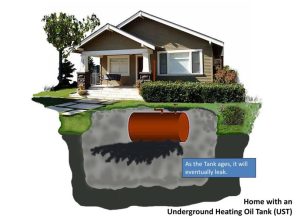You may ask, what is a heating oil tank or underground storage tank and where would it be? I don’t see it? Why is that a problem?
What Are Underground Oil Tanks ?

Underground Heating Oil Tanks (USTs) are buried tanks containing #2 diesel heating oil that is used to heat some homes. Prior to the common use of natural-gas, it was common-place for properties to contain buried underground heating oil tanks so that each property could stock-pile fuel used for heating. While it is common to find older homes/buildings with heating oil tanks, it is also possible that newer homes located in remote areas may also have heating oil tanks.
When Should I do an Underground Storage Tank Sweep?
Prior to purchasing any property, it is always recommended that a “tank search/sweep” be conducted to search for the possibility of any underground heating oil tanks (USTs) that may be located on the property. The presence of an oil tank can prove timely and costly. Many of these tanks have been buried for decades; being exposed to a number of risks that may lead the tank to deteriorate.
Why is an Underground Oil Tank dangerous?
Over time, underground storage tanks tend to corrode and rust; forming holes along the body of the tank that allow oil to leak from the tank into the surrounding soil. In some cases, the leak could be substantial enough that it may affect neighboring properties and/or the groundwater.
If this were to happen, the property owner (also known as the Responsible Party) would be on the hook for all cleanup (remediation) activities required by the New Jersey Department of Environmental Protection (NJDEP).
Prior to you purchasing a property, this issue (if present) would lie on the current property owner (seller). However, after the purchase of the property, you own this issue. For this reason, it is highly recommended that a tank sweep be conducted during the due diligence period of every home/building purchase. When in doubt, you should also consult your agent and/or attorney.
At Point Enviro, we utilize several location methods in order to locate any buried underground storage tanks. Depending on the property layout, conditions and/or the client’s wishes, we can utilize the following methods.
Ground Penetrating Radar operates similarly to a sonar. A tiny pulse of energy is emitted into the ground, recording the strength and time it takes for the signal to return from the reflected object.
This signal is exhibited on a visual screen and allows for the accurate detection of buried underground objects; regardless of their composition. Limitations of this method include, but are not limited to landscaping, heavy underground debris and limited accessibilities to areas.
A Field Magnetometer operates similarly to a metal detector. This method commonly allows us to detect buried metallic objects to a maximum depth of 9 feet below grade surface (bgs).
Limitations to this method include, but are not limited to areas where metallic objects such as fences and/or vehicles are tightly arranged.
A pipe and cable locator is utilized when one or more accessories related to a heating oil tank are visible, but the location of the tank itself is not known. A pipe and cable locator consist of two parts. One part is a battery powered signal emitter that is clipped to the visually accessible accessory.
The other is a wand that is programmed to seek out the signal being emitted. Limitations to this method include, but are not limited to areas where no accessories are visually/physically observed or accessible.
Each method has its useful application; with the Ground Penetrating Radar (GPR) being the most accurate in most situations. Combinations of several methods are also commonly used as no two properties are the same.
Contact us for your underground storage tank and oil tank sweeps. Get a quick quote today!
Call Us
Contact us at 201-690-7008
Email Us
Do you have a question? Click to contact us by email
Request Service
Fill out our service request form
